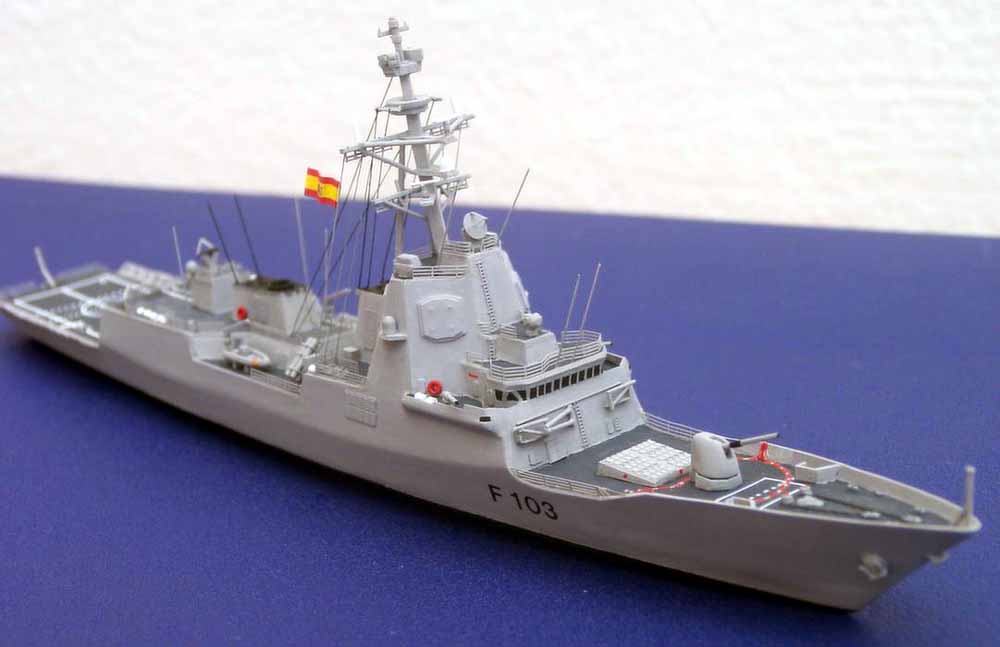by Luis Crespo

1/700 Spanish AEGIS Frigate F 103 Blas de Lezo (Scratchbuilt)

The real thing:
The spanish AEGIS frigate Blas de Lezo entered active duty in December 2004. She is the third vessel of the Álvaro de Bazán class. She was named after Don Blas de Lezo y Olavarrieta (Pasajes, Guipúzcoa, 1687 - Cartagena de Indias, 7-IX-1741), spanish admiral known as "Admiral One Leg" who defeated British admiral Vernon in the Siege of Cartagena, during the "War of Jenkins' Ear".
The devolopment of the Álvaro de Bazán class, also known as F 100 class, started when the NFR 90 Project was abandoned, back in the eighties. The multinational frigate would have formed the backbone of the spanish navy in the late nineties and well into 21st century, so the armada had to build two additional Santa María (OHP) class frigates to bridge the gap between the never born ships and a brand new locally designed class of surface combattants.
At that stage, the Armada and Bazán (later Izar and now Navantia) shipbuilders, admitting that some key technologies would have to be purchased abroad, reached an agreement with their German and Dutch counterparts, so projects F 100, F 124 and LCF would share several systems and technologies, specifically the APAR (Active Phased Array Radar) that was being devoloped.
However, it was soon evident that the european option implied heavier technological risks and, while could be considered a better option in the long term, was considerably more expensive than the proven AEGIS technology which was finally selected and integrated in the spanish designed platform.
As a result, Álvaro de Bazán class frigates are the smallest SPY-1D / AEGIS vessels around. Small cousins of Arleigh Burke and Kongo class destroyers, they deploy the same basic systems and weaponry at less cost. They are also the first european new generation AAW vessels. In fact they could be well considered DDG´s despite their official designation as frigates.
The Blas de Lezo is at the present moment performing her last trials before becoming fully operational.
Her statistics are:
| Displacement: | 5,802 tons full load. Might grow to 6,000 tons. |
| Dimensions: | 146.7 x 17.5 (481 x 57.5 feet) |
| Propulsion: | 2 shafts, 2 Bazan/MTU cruise diesels; 2 LM2500 boost gas turbines, 47,494 shp, 29 knots |
| Crew: | 229 +16 flag + 5 transients |
| Aviation: | aft helicopter deck & hangar with RAST; 1 SH-60B |
| Radar: | SPY-1D multifunction |
| Sonar: | DE1160 bow |
| Fire Control: | Aegis AAW system, DLT-309 ASW system, 2 Mk 99 missile control with SPG-62 radars |
| EW: | Aldebaran & Mk9000, 2 SRBOC, SLQ-25A Nixie |
| Armament: | 48 cell "strike" VLS (Standard SM-2MR, ESSM, Tomahawk capable) |
| 8 Harpoon SSM | |
| 1 5/54" DP | |
| 4 12.75 inch torpedo tubes | |
| 2 20 mm Meroka CIWS | |
| 2 12.7 mm MG | |
The model:
As usual, there is no commercial kit for these ships, so I had to build my "Blas de Lezo" from scratch.
The hull and decks are made of polystyrene sheet (0.5 mm).
I used Revell Harpoons, and 5/54" gun.
The mast is a heavily modified Arleigh Burke´s. The VLS and RHIB´s also come from the same Revell Arleigh Burke, sacrified for her pieces.
Doors and hatches, ventilation grilles, illuminators and some other pieces of PE come from an Eduard Ticonderoga set. Railing is from Tom´s Modelworks, and Rigging is 6/0 silk.
I include a couple of pictures of the Blas de Lezo alongside my Cazadora and Andalucía. Several other Spanish ships are on the way.